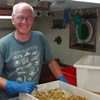General Description
Carapace pear-shaped, covered with bumps, with 5 strong spines protruding from each side. Rostral spines slender, strongly curved outwards. Walking legs long, spindly and slightly flattened with second last segment (propodi) expanded. Up to 3.7 mm long.
Biology
Decorative sponges, seaweeds and sea mosses are attached to stiff curved hairs on the carapace and legs. The two rostral spines can be seen to diverge and curve outwards once the camouflage has been removed. This camouflage, and moving very slowly, makes them hard to see in their natural habitat. Males have stronger claws than females.
Habitat
Low intertidal reef to 85 m depth.
Soft substrates
Reefs
Coastal shores
Distribution guide
Southern temperate oceans, including south-eastern Australia.
Species Group
Depth
Shore (0-1 m)
Shallow (1-30 m)
Deep ( > 30 m)
Water Column
Max Size
4 mm
Diet
Organic matter
Harmful
Not harmful but a nip from large claws could be painful.
Commercial Species
No
Global Dispersal
Native to Australia
Species Code
MoV 743
Conservation Status
- DSE Advisory List : Not listed
- EPBC Act 1999 : Not listed
- IUCN Red List : Not listed









